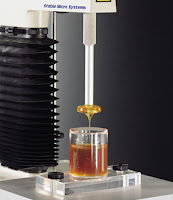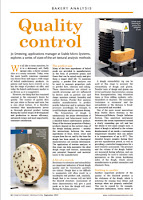 Baking a cake from scratch at home for a family member’s birthday celebration is one thing; baking a cake for sale in a grocery store is another.
Baking a cake from scratch at home for a family member’s birthday celebration is one thing; baking a cake for sale in a grocery store is another. As long as you use the correct ingredients and follow the recipe, the cake you bake at home is pretty much guaranteed to be moist and delicious.
However, cake products that are produced for sale in grocery stores, convenience stores, and vending machines have to survive the rigours of industrial processing and packaging, shipping, and shelf life. Some are packaged and sold as ready-to-eat products, while others are baked and frozen.
Product developers have to choose the appropriate ingredients and combine them to develop appealing products that can meet the demands of food processing and consumer requirements, such as the need to purchase ‘free-from’ products. The underlying issue when developing gluten-free cakes or removing key ingredients like egg whites or certain types of fats, or just developing a shelf-stable cake or cake mix, is texture. Common challenges include retaining a moist crumb throughout storage, achieving high volumes in finished cakes, and maintaining consistency of shape from loaf to loaf.
Gluten-free
A developer must achieve the volume, cell structure, texture, mouthfeel and shelf life that are created by a gluten matrix without using gluten.
Manufacturers continue to ask for assistance with formulating gluten-free cake products, making it one of the top concerns in cake product development. Formulating gluten-free products, especially bakery products like cakes, poses unique challenges to product developers. Gluten contributes so much to cake batters and finished cakes, especially in terms of texture and volume. If appropriate ingredients are not used, the finished product is dense and flavourless, and will not appeal to consumers.
Wheat flour is removed from the formulation when developing gluten-free cake, and depending upon the type of flours added back to replace the wheat flour, the finished product could become either very crumbly or too cohesive. Formulating with gluten-free flours can result in batters that are thinner in viscosity and less stable, producing an open crumb structure that is inconsistent, firm and dry.
Another consideration is cost. Replacing wheat flour with more expensive ingredients would add cost and make gluten-free products more cost prohibitive to purchase by the consumer. In addition, many gluten-free baked goods have a shortened shelf life due to the product becoming stale with a dry texture. The large proportion of starch in the formula retrograded rapidly.
Egg Replacement
Egg replacement is probably one of the biggest issues in the baked goods area because of the drastic rise in egg white prices in the last year or so. A huge request currently in the cake area is replacing egg whites in angel food cakes. It’s a real challenge because egg whites are so functional in this type of cake. Ingredient manufacturers can help product developers control costs in formulas that require eggs by the substitution of starches and starch and gum blends that can partially or fully replace eggs in formulations. Even when egg prices are much lower, the eggs could still make up close to 50% of the cost of a cake formulation.
Less Salt, Sugar & Fat
Cake is delicious, but the amounts of sugar and fat in it make it a less-than-healthful food choice. A number of factors are driving food manufacturers to reduce fat, sugar, overall calories, and even sodium in many products, including cake. No doubt consumer demands for healthier food options are having an effect on product development efforts. Fat, sugar, and sodium have functional benefits in cake formulations, and reducing their amounts will affect the texture, flavour, and overall acceptable eating experience of the finished product.
As a result, ingredient manufacturers are working closely with product developers to formulate cake products that have reduced calories, reduced fat/ no partially hydrogenated oils, or reduced sugar but still maintain the desired taste and other sensorial qualities that consumers expect. In other words “healthy indulgence” is a trend that continues to grow.
Whatever the desired result, when any change is made to a consumer product, a complete optimisation of the overall ingredients formulation is required. The interactions of each ingredient must be carefully considered and tested as each and every ingredient plays its part in the resulting final product. Take a chocolate cake that is positioned as a healthy indulgence as an example. A richer, darker chocolate might require a slightly higher pH, which would mean more baking soda is needed within the leavening system for the balance of ingredients to help achieve the desired colour. Proper leavening is imperative to the final texture and healthy indulgence desired by consumers.
Across many food categories, including bakery applications like cake, product developers are investigating lower sodium ingredient options. Some types of cakes like angel food cake traditionally do not contain fat but are made with egg whites, which contribute to aeration. In other cakes, volume is developed by butter, oil, or shortening, which also contribute to the mouthfeel and texture. Starches, gums, or combinations of both can be used in cake formulations to mimic the mouthfeel of full-fat products.
In addition, to reformulating cake products with better-for-you fats, manufacturers are also experimenting with ingredients to help reduce or replace sugar for calorie reduction. Fibres and resistant starches help to reduce the caloric density of cake by replacing digestible carbohydrate with indigestible or partially digested ingredients such as resistant starches.
Adding texture for appealing cakes
Cake that is formulated and baked to perfection is delicious on its own, but to add visual interest and additional flavour impact as well as provide a variety of textures, bakers can use frostings, icings, glazes, and inclusions. To improve the structure and stability of frostings and icings, starches and maltodextrins can be added with the additional benefit of enhancing water-holding properties and imparting creamy mouthfeel and glossy appearance. Inclusions can be made with real or restructured fruits and encapsulation techniques to improve flavour delivery and performance can also be employed. Processing techniques and formulations used in making encapsulated products have helped bakeries avoid issues with stickiness or smearing of bakery toppings on packaging.
Measure and Guarantee Textural Quality
When making any change to formulation the effect on texture should be measured and quantified. Here are a few options of measurement:
Cake Batter Consistency:
|
|
|
|
Request our Bakery Quality Control feature...

And for more information on how to measure texture, please visit the Texture Analysis Properties section on our website.
 The TA.XTplus texture analyser is part of a family of texture analysis instruments and equipment from Stable Micro Systems. An extensive portfolio of specialist attachments is
available to measure and analyse the textural properties of a huge range of
food products. Our technical experts
can also custom design instrument fixtures according to individual
specifications.
The TA.XTplus texture analyser is part of a family of texture analysis instruments and equipment from Stable Micro Systems. An extensive portfolio of specialist attachments is
available to measure and analyse the textural properties of a huge range of
food products. Our technical experts
can also custom design instrument fixtures according to individual
specifications.No-one understands texture analysis like we do!
To discuss your specific test requirements, click here...
|













No comments:
Post a Comment